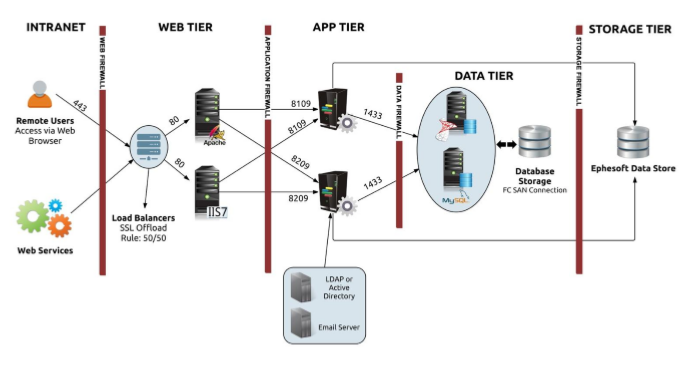Communication
Transact is a thin-client application so there is no client-side software that needs to be installed. It is designed so that centralized access can be achieved for administrators and operators, regardless of their location. Proper firewall routing, port-forwarding, and DNS configurations are necessary if communication with remote administrators or operators is needed
Client and Server communication
Communication from a client workstation is performed using HTTP/HTTPS through a standard web browser. This includes configuration and maintenance of the system along with operator functions, such as web scanning, batch uploads and exception handling.
The following diagram shows how communication takes place between different tiers of an Transact infrastructure, including remote admins and operators. This is not the only way to architect an Transact installation but is a highly secure, recommended approach.

Communication with third-party systems
Transact can communicate with other systems and applications during different parts of the capture process. These areas could be batch ingestion, database lookups during extraction or exporting documents and metadata to another application. There are several ways that this communication takes place and it depends on the specific task that is invoking the communication. Here are some common ways that Transact communicates with other systems:
-
CMIS
(Content Management Interoperability Services) -
Importing documents to be processed.
Exporting documents and metadata.
-
Database Connection Manager
- JDBC drivers to connect to external databases.
- Lookups during extraction or validation.
- Export documents and metadata to other databases.
-
Web Service APIs
- Real-time integration and exposure of Transact processes to other apps.
- Embed advanced capture technology in other systems (Please review the section on web service APIs for more information).
-
XML
Export XML files containing all document metadata.
-
Scripting Plugins
Custom scripts can be introduced at any step in the workflow.
Port communication
Transact requires certain ports to be open in order to function properly. The following table displays the port number, purpose, whether inbound or outbound rules need to be created, and which network protocol the firewall exception must use.
| no | Port # | Inbound / Outbound | Network Protocol |
|---|---|---|---|
| 1 | 8080 | Inbound and Outbound | TCP |
| 2 | 21099 | Inbound and Outbound | TCP/UDP |
| 3 | 8009 | Local communication only | N/A |
| 4 | 8100 | Local communication only | N/A |
| 5 | 80 | Inbound and Outbound | TCP |
Transact will also use the default ports for database connections and authentication protocols. Those ports are the following:
- MySQL - 3306
- MSSQL - 1433
- LDAP - 389
- Active Directory - 3268
